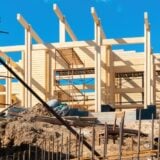Sales of holiday homes in the United States fell in 2016 for the second year in a row and have now fallen 36% from their recent peak in 2014, new data shows.
Part of the reason may be that in some of the most popular holiday spots in the south and west of the country property prices have increased substantially and this is pricing potential buyers out of the market, according to the latest research from the National Association of Realtors (NAR).
Overall the number of holiday homes bought fell to 721,000 last year compared with almost a million such buyers in 2015 to their lowest since 2013 and in the meantime, the number of investors buying property has increased, up 4.5% to 1.14 million.
Lawrence Yun, NAR chief economist explained that in popular holiday home locations substantial buyer demand from strong job growth continues to outstrip the supply of homes for sale.
‘With fewer bargain priced properties to choose from and a growing number of traditional buyers, finding a home for vacation purposes became more difficult and less affordable last year,’ he said.
‘The volatility seen in the financial markets in late 2015 through the early part of last year also put a dent in sales as some affluent households with money in stocks likely refrained from buying or delayed plans until after the election,’ he added.
Tight inventory conditions pushed the median sales price of both vacation and investment homes last year to levels not seen in roughly a decade. The median vacation home price was $200,000, up 4.2% from 2015 and the highest since 2006. The median investment home sales price was $155,000, up 8% from 2015 and the highest since 2005.
The NAR research also found that with home prices steadily rising, an increasing share of second home buyers financed their purchase last year. The share of vacation buyers who paid fully in cash fell to 28% from 38% in 2015, while cash purchases by investors decreased to 35% from 39% in 2015 and 41% in 2014.
‘Sales to individual investors reached their highest level since 2012 as investors took advantage of record low mortgage rates and recognized the sizeable demand for renting in their market as renters struggle to become homeowners,’ said Yun.
‘The ability to generate rental income or remodel a home to put back on a market with tight inventory is giving investors increased confidence in their ability to see strong returns in their home purchase,’ he pointed out.
Vacation sales accounted for 12% of all transactions in 2016, the lowest share since 2012 and down from 16% in 2015. The portion of investment sales remained unchanged for the third consecutive year at 19% and owner occupied purchases increased to 70% from 65% in 2015.
Given the rising popularity of short term rentals in locales throughout the country, Yun said it is no surprise there were slightly more investment and vacation buyers renting their property for less than 30 days. Some 44% of investors and 29% of holiday home buyers did or tried to rent their property last year and plan to do so in 2017 compared to 42% and 24% respectively in 2015. Some 21% of investment buyers and 15% of vacation buyers did not rent their home for short term purposes last year but plan to try it in 2017.
Vacation buyers’ typically earned $89,900, less than the $103,700 in 2015, while investment buyers had a household income of $82,000, less than the $95,800 in 2015. Both were most likely to purchase a home in the South, with vacation buyers preferring a beach location and investors choosing a suburban area.
The top two reasons for buying a vacation home were to use for holidays or as a family retreat with 42% doing so, while 18% bought for their future retirement. For investors some 42% bought a property to generate income through renting while 16% did so for potential price appreciation.






